How Long Does Curry Last in the Fridge
Your curry's safe storage time in the fridge depends on its ingredients and how you've stored it. Vegetable curries typically last 2-3 days, while meat-based curries should be eaten within 1-2 days. Fish curries need to be consumed within 24 hours. For ideal freshness, store your curry in airtight containers at temperatures below 40°F (4°C), and make certain to cool it within 1-2 hours before refrigerating. Watch for signs of spoilage like off-odors, discoloration, or unusual texture changes. You'll want to follow proper storage techniques to maximize your curry's shelf life and guarantee food safety. The specific details for each curry type reveal important differences in storage duration.
This post may contain affiliate links. If you make a purchase through these links, I may earn a commission at no additional cost to you. Additionally, portions of this post may be generated using artificial intelligence (AI) technology. While we strive for accuracy, please be aware that AI-generated content may not always be perfect and should be fact-checked when necessary.
The Spatula Scoops
- Vegetable curries last 2-3 days in the fridge, while meat-based curries should be consumed within 1-2 days.
- Store curry in airtight containers at 35-38°F (1.6-3.3°C) or below 40°F (4°C) for maximum safety.
- Tomato-based curries can last 3-4 days, while cream-based curries should be eaten within 1-2 days.
- Fish curries have the shortest shelf life and should be consumed within 24 hours of refrigeration.
- Cool curry within 1 hour before refrigerating and discard if left at room temperature for more than 4 hours.
Safe Storage Time for Curry
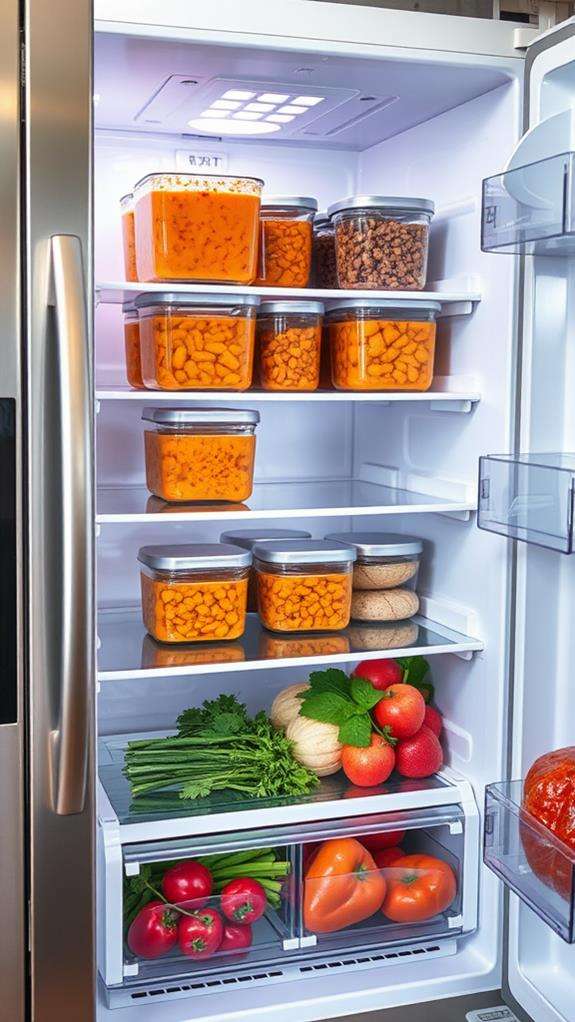
Curry's shelf life in the refrigerator typically ranges from 2-3 days when stored properly. You'll want to monitor both temperature and storage conditions carefully, as these factors greatly impact how long your curry remains safe to eat. The ideal refrigerator temperature should stay between 35-38°F (1.6-3.3°C) to maintain food safety.
For maximum freshness, you'll need to store your curry in an airtight container within two hours of cooking. If you've left your curry at room temperature for more than four hours, it's best to discard it, as bacteria can multiply rapidly in the "danger zone" between 40-140°F (4-60°C). You can tell if your curry has gone bad by checking for signs like an off smell, unusual texture, or visible mold growth.
Different curry types may have varying shelf lives. Vegetable-based curries typically last 2-3 days, while meat-based versions should be consumed within 1-2 days. If you've added dairy products like coconut milk or cream, you'll notice the curry's quality deteriorating faster, so it's best to consume these within 24-48 hours.
Signs of Spoiled Curry
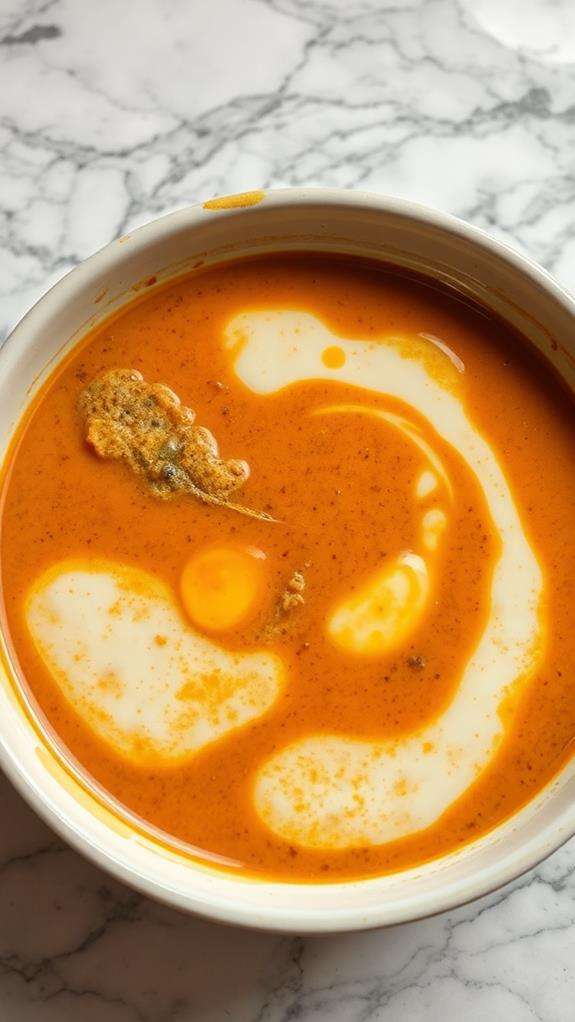
When checking if your curry has spoiled, you'll want to look for obvious visual warning signs like discoloration, mold growth, or an oily film on the surface. Your nose is also a reliable tool, as spoiled curry will often give off sour, rancid, or unusually strong odors that differ from its original aroma. The texture can reveal spoilage too, so watch for any unusual separation of ingredients, excessive thickening, or a slimy consistency that wasn't present when the curry was fresh.
Visual Warning Signs
Looking for visual cues is your first line of defense in identifying spoiled curry. You'll want to examine your curry carefully under good lighting, checking for any unusual color changes or surface abnormalities that might indicate spoilage.
| Visual Sign | What to Look For | Action Required |
|---|---|---|
| Discoloration | Darkening or fading from original color | Discard immediately |
| Surface Growth | White, green, or black spots | Throw away without tasting |
| Separation | Excessive oil or water pooling | Check other signs before deciding |
When you're examining your curry, you'll notice that fresh curry maintains its vibrant, consistent color throughout. If you spot any fuzzy patches or notice that the surface has developed a film-like appearance, don't take chances – these are clear indicators of microbial growth. Pay special attention to the edges and surface of your curry where it meets the container, as these areas often show the first signs of spoilage. If your curry contains coconut milk, you'll need to be particularly vigilant, as it's prone to separation and can make identifying genuine spoilage more challenging.
Smell and Texture Changes
The next reliable indicators of spoiled curry are its smell and texture changes. When you're checking your curry, you'll notice that spoiled curry develops a sour, rancid, or fermented odor that's distinctly different from its original aromatic spice blend. If you detect any musty or off-putting scents, it's best to discard the dish immediately.
As for texture, you'll want to examine both the sauce and solid components carefully. Fresh curry sauce should maintain a relatively uniform consistency, but when it's spoiled, you'll notice separation that won't remix properly. The sauce might become unusually thick, grainy, or develop a slimy film on top. If your curry contains meat or vegetables, these ingredients may feel slimy or mushy to the touch, having lost their original firm texture.
You should also watch for any signs of curdling in curry dishes that contain dairy products like yogurt or cream. When these ingredients begin to separate or form small lumps, it's typically a sign that bacteria have started breaking down the proteins, making the curry unsafe to consume.
Proper Storage Techniques

You'll need to store your curry in an airtight container with a tight-fitting lid, ensuring there's minimal headspace to prevent excess air from causing premature spoilage. For ideal temperature control, place your curry in the main compartment of your refrigerator where it stays consistently between 35-38°F (1.7-3.3°C), not in the door where temperatures fluctuate. When transferring hot curry to storage containers, let it cool for no more than two hours at room temperature before refrigerating, as this helps prevent condensation while maintaining food safety standards.
Airtight Container Storage Tips
Proper storage in airtight containers can greatly extend your curry's shelf life and maintain its quality. When selecting containers, opt for glass or BPA-free plastic options with secure, snap-tight lids that create a reliable seal. You'll want to choose containers that are appropriately sized for your portions to minimize air exposure.
Before transferring your curry, let it cool completely to room temperature, but don't leave it out for more than two hours. Fill your containers leaving about half an inch of headspace at the top, which allows for slight expansion while preventing excess air. You'll need to wipe the container's rim clean before sealing to guarantee a proper seal and prevent bacterial growth.
If you're storing multiple portions, divide your curry into smaller containers rather than one large one. This practice reduces exposure to air and temperature fluctuations when you're reheating portions. Label each container with the date you've stored it and the contents, using waterproof markers or labels that won't wash off. For curry with coconut milk, consider using containers with lockable lids, as these curries tend to separate and may leak.
Temperature Control Guidelines
Maintaining consistent temperature control starts with your refrigerator's settings. You'll want to keep your curry stored at 40°F (4°C) or below to prevent bacterial growth and maintain food safety. Your refrigerator's main compartment should consistently maintain this temperature range, and it's worth using a thermometer to verify the settings are correct.
When storing curry, you'll need to follow these critical temperature guidelines to maximize its shelf life:
- Don't let your curry sit at room temperature for more than 2 hours before refrigerating
- Cool hot curry to room temperature within 1 hour before refrigeration
- Store curry in the main compartment, not the door where temperatures fluctuate
- Keep curry away from the back wall to prevent freezing
- Check your refrigerator's temperature weekly with a reliable thermometer
If you're portioning curry for later use, make sure you're working quickly to maintain proper temperature control. When reheating, your curry should reach 165°F (74°C) throughout to eliminate any potential bacteria that may have developed during storage. Remember that frequent temperature fluctuations can greatly reduce your curry's shelf life and compromise its safety.
Freezing Curry for Later
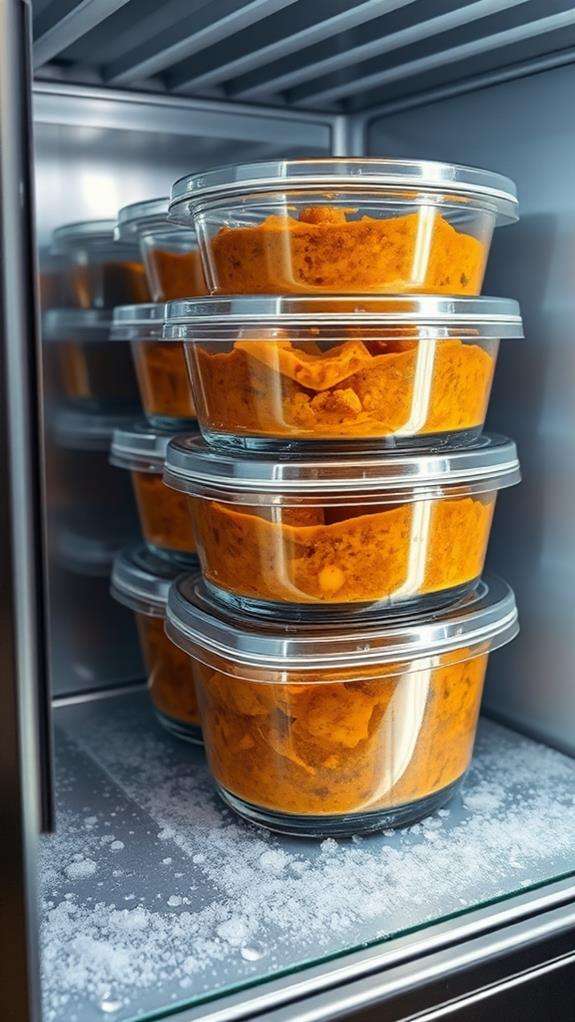
Freezing leftover curry provides an excellent way to extend its shelf life well beyond refrigeration. You'll want to let your curry cool completely before transferring it to freezer-safe containers or heavy-duty freezer bags, making certain to leave about an inch of headspace for expansion during freezing.
When properly stored at 0°F (-18°C), your curry can last up to three months while maintaining its quality and flavor profile. To prevent freezer burn, you'll need to remove as much air as possible from the storage container and seal it tightly. It's helpful to portion your curry into smaller serving sizes before freezing, so you won't need to thaw more than you'll use at once.
When you're ready to use your frozen curry, transfer it to the refrigerator and let it thaw overnight. You can reheat it on the stovetop over medium heat, stirring occasionally to guarantee even warming. If you notice any separation, particularly in coconut milk-based curries, simply whisk the curry while reheating to restore its original consistency. Don't refreeze curry that's already been thawed, as this can compromise both safety and quality.
Different Curry Types and Shelf Life
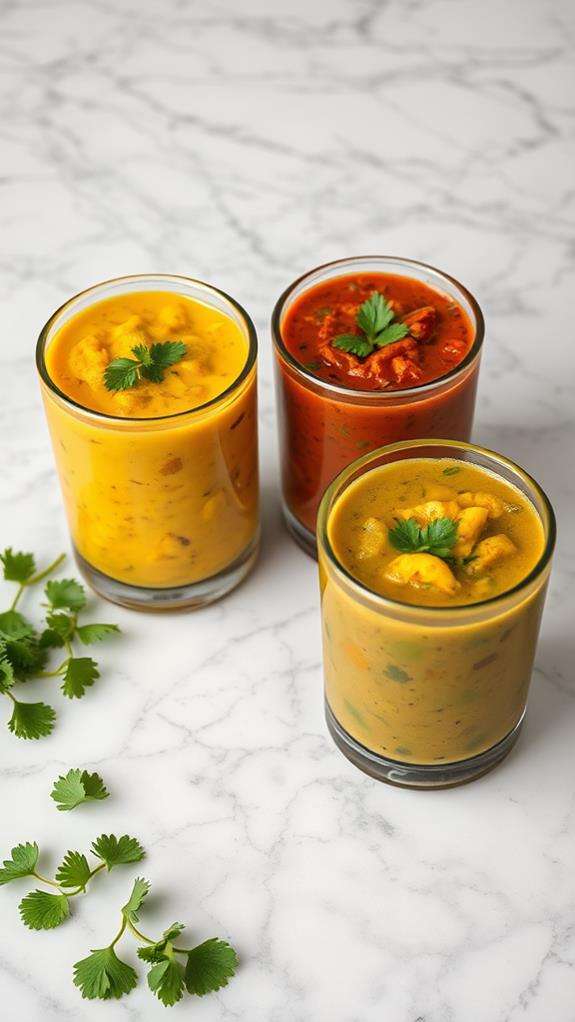
Various curry types can have markedly different shelf lives in your refrigerator, largely depending on their main ingredients and preparation methods. You'll find that vegetable-based curries typically last 3-4 days, while meat-based versions should be consumed within 1-2 days for ideal safety and flavor.
When you're storing different curry types, keep these shelf-life guidelines in mind:
- Coconut milk-based curries (like Thai green curry) last 2-3 days due to dairy content
- Tomato-based curries (such as Rogan Josh) remain fresh for 3-4 days
- Lentil-based curries (like Dal) stay good for 4-5 days
- Fish curries should be eaten within 24 hours
- Cream-based curries (including Butter Chicken) last 1-2 days
The presence of dairy products, seafood, or meat considerably impacts storage duration. You'll notice that vegetarian options containing mostly shelf-stable ingredients tend to last longer. Temperature control is essential – your refrigerator should maintain a consistent temperature below 40°F (4°C). If you've added fresh herbs or garnishes to your curry, these elements may deteriorate faster than the curry itself, affecting overall quality even if the base remains safe to eat.
Reheating Your Leftover Curry
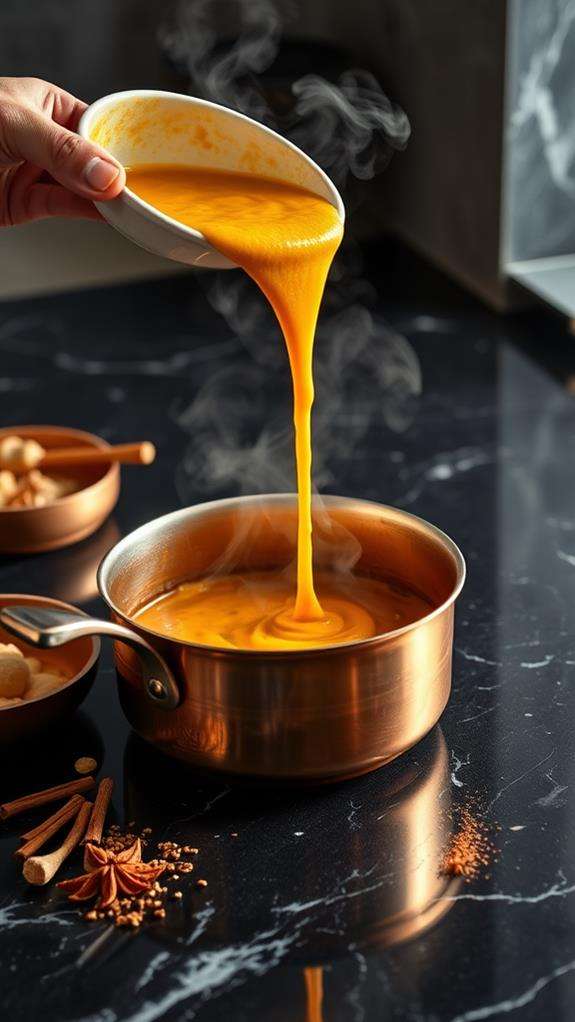
Once you're ready to enjoy your stored curry, proper reheating methods can help maintain its original taste and texture. The best approach is to reheat your curry slowly on the stovetop over medium-low heat, stirring occasionally to guarantee even warming throughout the dish. You'll want to add a splash of water or stock if the curry seems too thick, as refrigeration can sometimes cause the sauce to thicken.
If you're using a microwave for convenience, transfer your curry to a microwave-safe container and heat it in 30-second intervals, stirring between each interval to distribute the heat evenly. Don't forget to cover the container with a microwave-safe lid or plate, leaving a small vent for steam to escape. This method helps prevent hot spots and maintains the curry's consistency.
For peak food safety, verify your curry reaches an internal temperature of 165°F (74°C) before consuming. You'll know it's properly reheated when it's steaming hot throughout. If you notice any separation in cream-based curries, gentle stirring during the reheating process will help recombine the ingredients.
Extending Curry Freshness
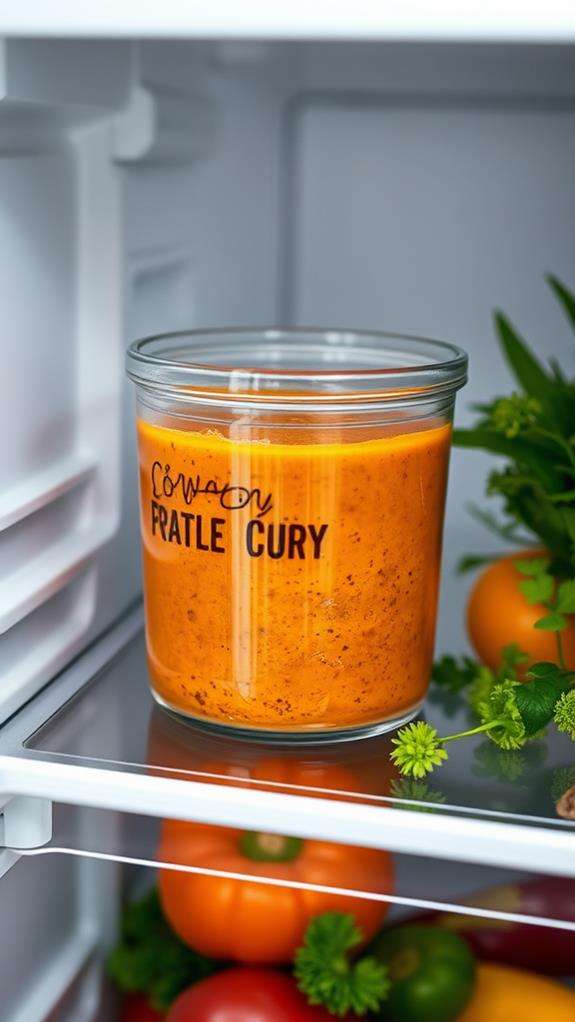
Smart storage practices can considerably extend your curry's shelf life beyond the usual 3-4 days. When you're storing curry, it's essential to focus on temperature control, container selection, and proper sealing techniques that will maximize its freshness and prevent bacterial growth.
To maintain your curry's quality and extend its refrigerator life, you'll want to implement these vital preservation methods:
- Store curry in airtight, shallow containers to guarantee quick cooling and minimal bacterial growth
- Keep your refrigerator temperature at or below 40°F (4°C) to slow down microbial activity
- Place curry in the main body of the fridge rather than the door, where temperatures fluctuate
- Use glass containers instead of plastic ones to prevent staining and absorption of flavors
- Remove curry from copper or brass vessels before storing, as these metals can react with acidic ingredients
Remember to cool your curry completely before refrigerating, but don't let it sit at room temperature for more than two hours. If you're dealing with a large batch, divide it into smaller portions for faster cooling and easier reheating. This approach will help maintain both safety and flavor quality throughout the storage period.
Food Safety Tips for Curry
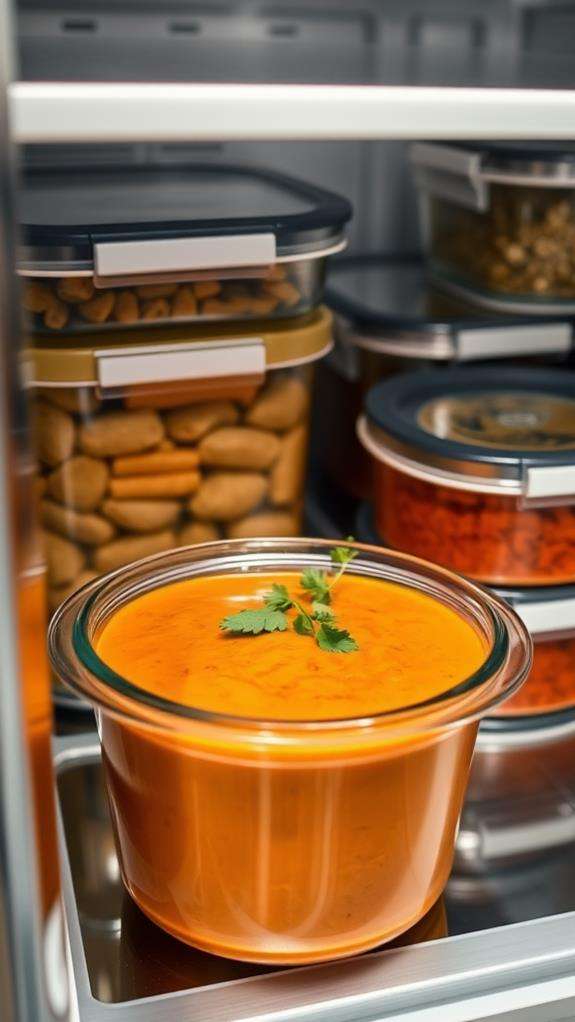
Essential food safety practices can mean the difference between enjoying your curry safely and risking foodborne illness. You'll need to monitor temperature, storage conditions, and handling procedures to keep your curry safe for consumption. When storing curry, always use airtight containers and guarantee your refrigerator maintains a temperature below 40°F (4°C).
| Safety Measure | Implementation |
|---|---|
| Temperature Control | Keep hot curry above 140°F, cold curry below 40°F |
| Storage Containers | Use clean, airtight containers with secure lids |
| Cooling Process | Cool within 2 hours; divide large portions |
| Cross-contamination | Use separate utensils for raw and cooked ingredients |
| Reheating | Heat thoroughly to 165°F throughout |
Don't leave your curry at room temperature for more than two hours, and if you're serving it at a party, use a chafing dish or slow cooker to maintain safe temperatures. When reheating, guarantee it's steaming hot throughout, and never reheat curry more than once. If you notice any off-odors, unusual coloring, or mold growth, it's best to discard the curry immediately rather than risk getting sick.
Frequently Asked Questions
Can I Mix Different Types of Curry Leftovers Together?
While you can mix different curry leftovers, you'll want to contemplate their flavor profiles first. Combining curries with similar base ingredients and spice blends (like masalas) usually works better than mixing contrasting styles. You'll get the best results if you mix curries that share common elements, such as coconut-based Thai curries or tomato-based Indian curries. Be mindful that mixing different curries may alter their original tastes markedly.
Does Eating Cold Curry Straight From the Fridge Cause Digestive Issues?
While your rebellious spirit might enjoy defying culinary conventions, eating cold curry straight from the fridge isn't likely to cause digestive issues for most people. However, you'll get better flavor and texture by reheating it. If you've got a sensitive stomach, cold curry's congealed fats could cause mild discomfort. For best enjoyment and digestion, you're better off taking those extra few minutes to warm it up properly.
Why Does My Curry Taste Better the Next Day?
Your curry tastes better the next day because of a process called "flavor melding," where spices and ingredients continue to interact overnight. You'll notice enhanced taste because the proteins in meat dishes have more time to absorb spices, while the fats help distribute flavors more evenly. The cooling and reheating process also breaks down fibrous vegetables further, making them more tender and allowing them to release additional flavor compounds.
Should I Remove Whole Spices Before Storing Curry in the Fridge?
Yes, you should remove whole spices from your curry before refrigerating it. Large spices like cinnamon sticks, bay leaves, and cardamom pods can become bitter and overpower your dish when left too long. They've already released their essential oils during cooking, so they're no longer needed. Simply fish them out with a spoon before storage. If you can't find all of them, don't worry too much – just remove what you can easily spot.
Can I Store Curry in Non-Airtight Containers if Covered With Foil?
You shouldn't store curry in non-airtight containers, even if covered with foil. While foil provides some protection, it can't create the secure seal needed to prevent bacterial growth, oxidation, and food spoilage. Additionally, foil-covered containers may allow curry to absorb unwanted refrigerator odors or let strong curry aromas seep into other foods. For food safety and quality, you'll want to use containers with tight-fitting lids specifically designed for food storage.





